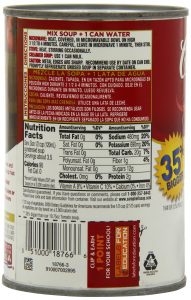What is sodium?
Sodium is a mineral, that is more commonly found in our diet as table salt. Our body relies on sodium for its most basic functions; however, our diet tends to provide us with more sodium than what our body needs. If your diet is very high in sodium, you are at increased risk for high blood pressure (hypertension), which then puts you at risk for heart disease, stroke, and kidney disease.
How much sodium do I need?
It is recommended that you try to eat less than 1500 milligrams (mg) of sodium in a day. If you were to visualize this, it would look like 2/3 of a teaspoon of salt! However, you should realize that you don’t only get sodium using the salt shaker or directly from table salt. In fact, most of the salt in your diet is invisible!
Where is sodium found?
Most foods naturally contain a small amount of salt. Processed and packaged foods on the other hand have much larger amount of salt! Namely canned foods, bread, cereals, cheeses, processed meat, sauces, quick rice and pasta mixes, condiments and pickled foods are very high in sodium. In addition to the sodium that comes from salt, there is sodium in other ingredients, such as baking soda.
 Half a can of this product provides you with 480mg of sodium.How can I take control of the amount of sodium in my diet?
Half a can of this product provides you with 480mg of sodium.How can I take control of the amount of sodium in my diet?
As mentioned, foods such as fruits, vegetables, grains, pulses, meat, chicken and fish are very low in sodium in their natural, unprocessed state. For these foods, you should only consider the salt that you add during cooking or at the table. For processed and packaged foods, you need to read the food label (nutrition information) to determine the amount of sodium.
How much sodium is in common foods?
Remember that you should aim for a sodium intake of about 1500mg and no more than 2300mg. It is very easy to exceed the 1500mg recommended intake just by following an average diet. Below, you can review the sodium content of common foods.
| Food | Sodium Content |
| 1 tsp (5 ml) salt | 2300 mg |
| 1 slice bread | 182-211 mg |
| 1 cup (250 ml) cottage cheese | 736-970 mg |
| 1.5 oz (40 g) cheese | 352 mg |
| 3 oz (85 g) unsalted chicken | 302-960 mg |
| Two slices of bacon | 356 mg |
| ½ cup (125 ml) fresh or frozen cooked green beans | 0 mg |
| ½ cup (125 ml) canned green beans, drained | 188 mg |
| 3/4 cup (175 ml) canned beans | 489-638 mg |
| 1 cup (250 ml) whole milk | 257 mg |
| 1 Tbsp (15 ml) salad dressing | 170mg |
| 1 cup (250 ml) canned tomato soup | 529mg |
| 3/4 cup (175 ml) Breakfast Cereal | 92-231 mg |
What are some easy steps to reduce my sodium intake?
It is important to learn about the sources of sodium and monitor your intake of foods that are higher in this mineral. Learning to read the nutrition information helps you estimate the amount of sodium in processed and packaged foods. That being said, here are some steps that you can take to reduce your sodium intake:
- Purchase food in its raw or unprocessed state, and prepare it yourself. As mentioned, foods in their natural state tend to have very little sodium. Processing involves adding a lot of salt to food. Try to buy fresh meat and chicken, and fresh or frozen fruits and vegetables.
- Note that the canned version of the same food has a lot more salt! This is because salt is often used to preserve food. When purchasing canned products, either choose the “low sodium” version, or rinse the product before eating it.
- Read labels and compare different products to help you choose the one with less sodium.
- When preparing food, consider using more spices for flavouring instead of salt.
- Try to get used to lower sodium! Believe it or not, our sense of taste can change!!! Try to reduce your salt intake in small steps. It is amazing how your taste buds can adjust to the change. I invite you to challenge yourself.
High sodium intake could lead to high blood pressure, which as mentioned, is a risk factor for serious conditions such as heart attack, stroke and kidney disease. Monitoring your sodium intake makes a big difference and can help prevent these conditions, or if you are experiencing any of these health problems, it can help you control them and prevent more devastating outcomes.
References:
Dietitians of Canada. (2016, August 25). Dietitians of Canada – Food Sources of Sodium. Retrieved from http://www.dietitians.ca/Your-Health/Nutrition-A-Z/Minerals/Food-Sources-of-Sodium.aspx
Health Canada. (2016, July 14). Canadian Nutrient File. Retrieved January 23, 2017, from https://food-nutrition.canada.ca/cnf-fce/index-eng.jsp
